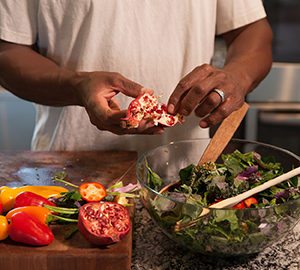Eating Heart-Healthy Food: Using the DASH Plan

Eating for your heart doesn’t have to be hard or boring. You just need to know how to make healthier choices. The DASH eating plan was created to help you do just that. DASH stands for Dietary Approaches to Stop Hypertension. This plan is proven to be healthier for your heart and to lower your risk for high blood pressure. It can also help lower your risk for cancer, stroke, heart disease, osteoporosis, and diabetes.
Choosing from each food group
Choose foods from each of the food groups below each day. Try to get the recommended number of servings for each food group. The serving numbers are based on a diet of 2,000 calories a day. Talk with your healthcare provider if you’re not sure about your calorie needs. Along with getting the correct servings, the DASH plan also advises less than 2,300 mg of salt (sodium) per day. Lowering sodium intake to 1,500 mg per day lowers blood pressure even more. (There's about 2,300 mg of sodium in 1 teaspoon of salt.)
Grains
Servings: 6 to 8 a day
A serving is:
Best choices: Whole grains and any high-fiber grains
|
Vegetables
Servings: 4 to 5 a day
A serving is:
-
1 cup raw leafy vegetable
-
Half a cup cut-up raw or cooked vegetable
-
Half a cup vegetable juice
Best choices: Fresh or frozen vegetables prepared without added salt or fat
|
Fruits
Servings: 4 to 5 a day
A serving is:
-
1 medium fruit
-
One-quarter cup dried fruit
-
Half a cup fresh, frozen, or canned fruit
-
Half a cup of 100% fruit juices
Best choices: A variety of fresh fruits of different colors. Whole fruits are a better choice than fruit juices.
|
Low-fat or fat-free dairy
Servings: 2 to 3 a day
A serving is:
Best choices: Skim or 1% milk, low-fat or fat-free yogurt or buttermilk, and low-fat cheeses
|
Lean meats, poultry, fish
Servings: 6 or fewer a day
A serving is:
Best choices: Lean poultry and fish. Trim away visible fat. Broil, grill, roast, or boil instead of frying. Remove skin from poultry before eating. Limit how much red meat you eat.
|
Nuts, seeds, beans
Servings: 4 to 5 a week
A serving is:
-
One-third cup nuts (1.5 ounces)
-
2 tablespoons nut butter or seeds
-
Half a cup cooked dry beans or legumes
Best choices: Dry roasted nuts with no salt added, lentils, kidney beans, garbanzo beans, and whole pinto beans
|
Fats and oils
Servings: 2 to 3 a day
A serving is:
Best choices: Nut and vegetable oils (nontropical vegetable oils), such as olive and canola oil
|
Sweets
Servings: 5 a week or fewer
A serving is:
-
1 tablespoon sugar, maple syrup, or honey
-
1 tablespoon jam or jelly
-
1 half-ounce jelly beans (about 15)
-
1 cup lemonade
Best choices: Dried fruit can be a satisfying sweet. Choose low-fat sweets. And watch your serving sizes!
|
Online Medical Reviewer:
Cunningham, Louise, RN
Online Medical Reviewer:
Gandelman, Glenn, MD, MPH
Date Last Reviewed:
10/1/2021
© 2000-2024 The StayWell Company, LLC. All rights reserved. This information is not intended as a substitute for professional medical care. Always follow your healthcare professional's instructions.